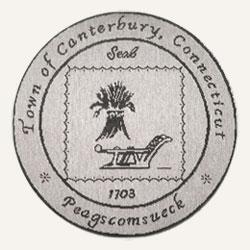
Canterbury's history begins several years before its 1703 settlement, when Maj. James Fitch of Norwich was granted title to a large tract known as the Quinebaug lands in 1680 by Owaneco, the son of Uncas, sachem of the Mohegans.
In 1697, Fitch made a settlement on a "neck of land" within a curve of the Quinebaug River, below the island of Peagscomsueck. Peagscomsueck had been an Indian fort on the Quinebaug River, and the name meant "a great brook."
Fitch's home, which he named Kent, was on the west bank of the river, but his property included rich farmland on both sides of the Quinebaug.
Other people began to settle on the west side of the river as well, and in 1699, all of this land was part of Plainfield.
By the fall of 1702, several west-side settlers had grown tired of crossing the Quinebaug River for church services in winter and at periods of high water, and wished to make a separation from Plainfield. Plainfield's residents called in three ministers to settle the problem. As a result, some articles of separation were quickly drawn up, advising the settlers to make their town's dividing line the river, and to organize as two distinct townships.
In December 1702, these articles of separation were drawn, signed, and witnessed. Almost a year later, on October 14, 1703, the Connecticut General Assembly granted that "the inhabitants on the west side of the river shall have the privileges of a township, and that the name of the town shall be Canterbury."
More detailed information about Canterbury's early days can be found at the Connecticut State Library in Hartford and in Ellen Larned's History of Windham County, available at the Canterbury Public Library and other local libraries.
[Excerpted from Canterbury The First 300 Years, Arcadia Publishing, 2003]
